42 Altitude Definitions & Measurement
Introduction
As with its airspeed, an aircraft’s altitude is also critical to its piloting and engineering. Pilots are concerned about an aircraft’s altitude relative to sea level or above ground, specifically during takeoff and landing, or when avoiding terrain. Naturally, the altitude reference (datum) used is essential so that all aircraft fly at altitudes measured relative to the same standard reference, which is necessary for air traffic control and collision avoidance. Pilots must also anticipate their aircraft’s performance, primarily depending on altitude and outside air temperature.
Engineers, however, are more interested in measuring air density at a given flight altitude. In this case, altitude measurements can be related to air density by measuring pressure and temperature, and then calculating density using the equation of state. Additionally, an altimeter is a pressure-measuring instrument by design, allowing the determination of local air pressure from altitude. The outside air temperature can also be measured during flight using a thermometer. Therefore, the proper basis of altitude measurement and how such measurements are used in engineering practice to find air density must be understood.
Learning Objectives
- Understand how an altimeter works and how to read one.
- Appreciate the principles associated with altitude measurement.
- Know the differences between pressure altitude and density altitude.
- Be able to calculate density altitude from values of temperature and pressure altitude.
What is an Altimeter?
Like the airspeed indicator (ASI), an altimeter is a pressure-measuring (pneumatic) instrument. An altimeter responds to ambient static pressure, so it must be connected to the aircraft’s static pressure reference source, i.e., the static port. However, unlike an airspeed indicator with two ports, one for total (or ram) pressure and the other for static pressure, an altimeter has only one port for static pressure. The mechanical design of an altimeter is shown in the schematic below. Although it appears relatively simple, it is a delicate and precise instrument that requires careful, repeated calibration for use in aviation practice.
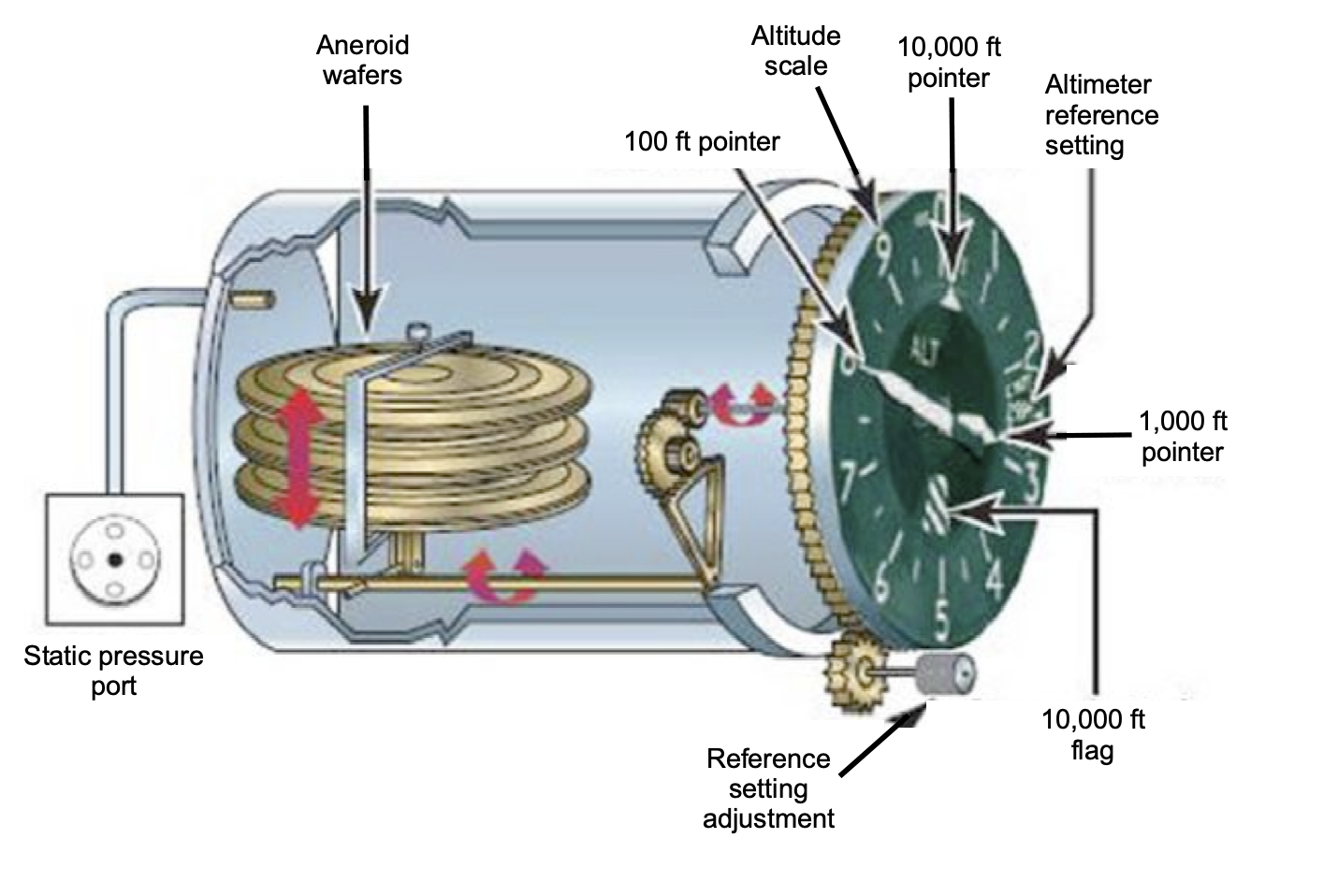
Inside the altimeter, the expansion and contraction of an evacuated aneroid wafer stack are detected by a system of levers and gears and then displayed by the rotational movement of the pointer (needles) on a face with a scale, much like that of a clock. The display of an altimeter has three needles or hands: One for 100s of feet, another for 1,000s of feet, and the third for 10,000s of feet. Notice from the figure above that the altimeter also has a setting window called the Kollsman window. On the bottom left side of the altimeter is a knurled adjustment knob used to adjust the reference pressure displayed in the Kollsman window. The altimeter will therefore read differently depending on the reference pressure value set in this window.
Reading an Altimeter
Reading an altimeter is relatively easy, but it does require some practice. In reference to the image below, the 10,000-foot pointer is the longest and narrowest needle on the altimeter; it rotates by one unit for every 10,000-foot change in altitude. The shortest and widest needle measures increments of 1,000 feet, so a full rotation of the needle is an altitude increment of 10,000 feet. The medium-length hand reads 100s of feet, so that a full rotation would be an altitude increment of 1,000 feet. In this regard, the numbers on the dial each represent 100-foot increments, and the tick marks between them represent 20-foot increments.
For example, in the case shown below, the 100-foot pointer is just past the number 4 (410 feet), the 10,000-foot pointer has just moved from 0, and the 1,000-foot pointer is between the 1 and the 2, so it is 1,000 feet plus. Therefore, in this case, the altimeter, as shown, reads 1,410 feet relative to the pressure datum value set in the Kollsman window.
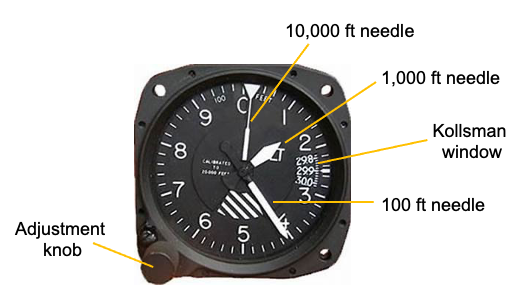
All aviation altimeters are formally calibrated to account for pressure variations in the International Standard Atmosphere (ISA). Typically, the mechanical design of an altimeter allows calibration within a certain tolerance, typically 20 feet for a general aviation (GA) aircraft, which is sufficient for piloting. However, for engineering use, a more precise and formal calibration will be necessary to account for mechanical errors, as with the ASI. This calibration is obtained by calibrating the altimeter in a vacuum tank relative to known pressure values or against a previously calibrated reference altimeter. Again, the results of the mechanical correction are usually presented as a chart or a table of values, along with those for the airspeed indicator.
Test Your Understanding of How to Read an Altimeter
Please look at the faces of the three altimeters, A, B, and C, as shown below. What is the altitude reading in each case?
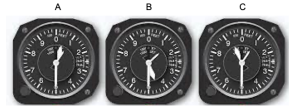
Answers: A: 10,500 feet. B: 14,500 feet. C: 9,500 feet
Review of ISA Pressure & Density Variations
Before proceeding with the formal definitions of pressure altitude and density altitude, it is helpful to summarize the previously derived equations of the International Standard Atmosphere (ISA).
ISA Temperature Variations
The temperature in the international standard atmosphere is given by
(1)
or
(2)
In this case, is expressed in feet (ft), and
is called the standard atmospheric lapse rate. This temperature lapse equation is valid only up to the troposphere’s limits, or about 36,000 ft. The value of
is 3.57
F per 1,000 ft of altitude or 0.00357
F per ft = 0.00357
R per ft.
In SI units, the ISA temperature lapse equation can be written as
(3)
or
(4)
where is expressed in meters (m), and the ISA lapse rate, in this case, is 6.5
C per 1,000 m. This lapse rate is also equivalent to 1.981
C per 1,000 ft, giving
(5)
with being measured in feet (ft). Measuring altitude in feet for aeronautical and aviation purposes is standard practice. Often, the ratio of the ISA temperature at a given altitude to the MSL temperature is used, which is given the symbol
, i.e.,
(6)
ISA Pressure Variations
The resulting local pressure in the ISA, , at any altitude
relative to the value at MSL,
, is
(7)
where in this latter equation is measured in feet (ft). Notice that in USC units, then
(8)
The gas constant for air, , in USC units is 1716.49 ft lb slug
R
and in SI units it is 287.057 J kg
K
. Therefore, the value of
, which is a non-dimensional grouping, is
(9)
so its numerical value does not depend on the unit system. If were to be measured in meters (m), then
(10)
where, in this case, using SI units gives
(11)
Remember that under standard MSL conditions, the value of is 2116.4 lb/ft
or 101.325 kN/m
.
ISA Density Variations
In accordance with the assumptions made with the ISA model, the pressure and density can be related using the equation of state, i.e.,
(12)
Therefore, if the local temperature corresponds to the standard local temperature in the ISA, i.e., , then
(13)
and so the local density in the ISA relative to MSL is
(14)
where is measured in feet (ft). If
is measured in meters (m), then
(15)
Remember that under standard MSL conditions, the value of is 0.002378 slugs/ft
or 1.225 kg/m
.
Pressure Altitude
As previously described, an altimeter is a calibrated pressure gauge, and its calibration is based on the ISA. Therefore, it makes sense to use the altimeter to measure the air pressure at which the aircraft is flying, which is performed by determining the pressure altitude. By definition, the pressure altitude, , is the altitude in the ISA corresponding to the prevailing ambient local static pressure. The advantage of using pressure altitude as a reference is that its value depends solely on the local ambient pressure.
Using the relationship for pressure in the ISA given by Eq. 10, the value of the pressure altitude, , as measured in feet (ft), is given by
(16)
(17)
The measurement pressure altitude from the altimeter will also be subject to static position (SPE) errors and mechanical errors (instrument error correction, or IEC), which must be obtained through calibration. The SPE error is obtained similarly to the airspeed indicator (ASI), where the true static pressure is measured well behind the aircraft during flight testing using a trailing cone apparatus, an example shown in the figure below. The SPE altitude error, , as it affects the true pressure altitude value, must be mapped out over the entire operating envelope of the airplane.
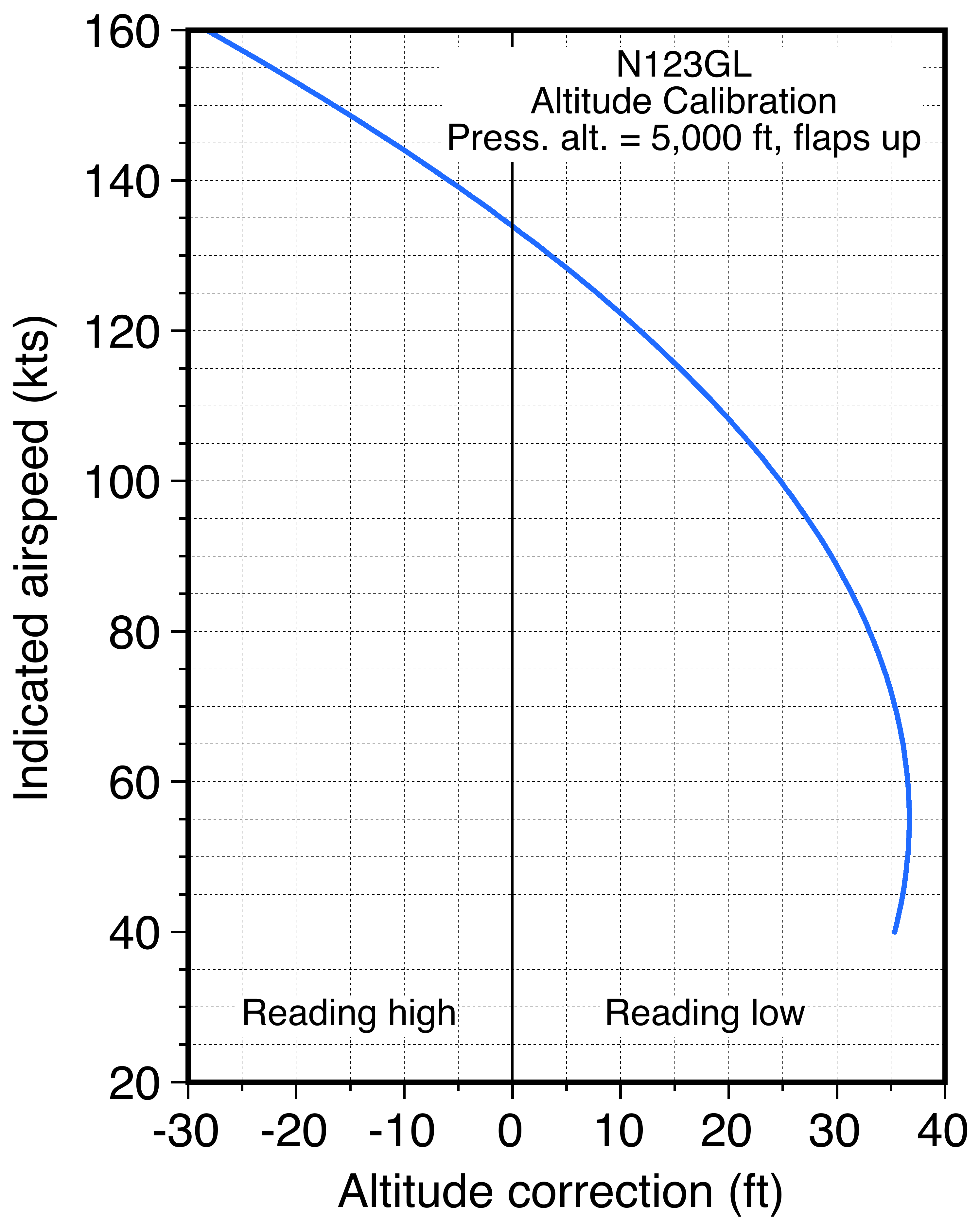
Likewise, with the IEC, the altimeter must be calibrated against a reference altimeter in an evacuated chamber to obtain , as shown in the example below. The data is usually presented in tabular form, although a curve fit may be used. The errors are generally minor but are non-negligible for engineering purposes.

The corrected pressure altitude is then
(18)
where is the indicated pressure altitude on the altimeter. Such errors are usually small enough to be ignored for piloting purposes, but they must be accounted for in engineering calculations, including those related to aircraft and engine performance measurements.
Density Altitude
While pressure altitude can be measured directly on a suitably calibrated altimeter, ultimately, the air density in which the aircraft is flying affects its performance and its engines. Therefore, determining the air density is required for engineering analysis and all types of performance work.
By definition, the density altitude, , is the altitude in the ISA that corresponds to the prevailing ambient density. The value of the density altitude (again, measured in units of feet) can be obtained by rearranging Eq. 14 to get
(19)
(20)
where is in units of feet.
Relating Density Altitude & Pressure Altitude
As previously explained, pressure altitude can be read directly using an altimeter calibrated according to the ISA using Eq. 17. However, the altimeter’s reference pressure must be set to the standard MSL value. This is done by setting the reading Kollsman window to the MSL ISA value of 29.92 in Hg (inches of mercury) or 1013.2 millibars (depending on the specific altimeter), which are equivalent to the ISA MSL or values of 2116.4 lb/ft
or 101.325 kPa, respectively, in engineering units. The value of
can then be directly read off the altimeter, assuming it is properly calibrated and that mechanical and static position errors are corrected.
Unlike pressure altitude, density altitude must be calculated from pressure altitude measurements corrected for non-standard ambient temperature conditions relative to the ISA temperature standard. In this regard, “nonstandard” refers to a local temperature that deviates (i.e., is higher or lower) from the ISA standard temperature value at a given pressure altitude. For example, the density will be lower at higher temperatures, but the density altitude will be higher than the pressure altitude.
Density Altitude Calculation
Recall that pressure and density are related using the equation of state, so the density ratio in the ISA can be written as
(21)
where is the local standard temperature according to the ISA as given by
(22)
where is the pressure altitude. If the pressure altitude and the outside air temperature,
, are both available (e.g., measured), then by using Eqs. 17 and 20 and some algebra, then the corresponding density altitude can be determined from
(23)
(24)
This means that Eq. 24 can be used to find the density altitude for any given pressure altitude and outside air temperature values. It can also be seen that if the local temperature equals the standard ISA temperature at the pressure altitude, i.e., , then
. Remember that all temperature values in these equations are absolute temperatures.
Armed with these equations, it is now possible to examine variations in density altitude with temperature for different pressure altitudes, as shown in the chart below in SI units. In this regard, it should be remembered that the value of in SI units
is 6.5
C per 1,000 m or 1.981
C per 1,000 ft. The diagonal lines represent constant-pressure altitudes. The blue line is the standard ISA temperature variation, giving
. Taking as an example
C and
m, then by following the red lines on the chart, the chart gives an estimated value of
of 8,200 m.
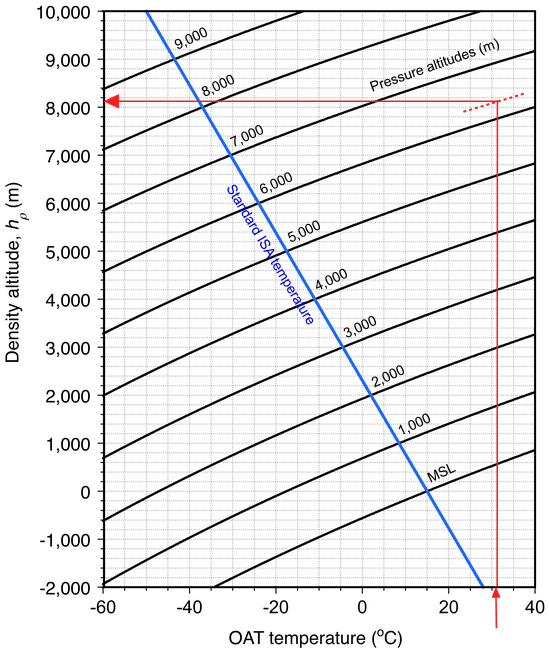
The same type of presentation, showing the variation in density altitude with temperature changes at different pressure altitudes, is shown in the chart below in USC units. In this case, is 3.57
F per 1,000 ft of altitude or 0.00357
F per ft = 0.00357
R per ft. Again, taking
F and
ft, following the red lines on the chart yields an estimated
of 23,000 ft.
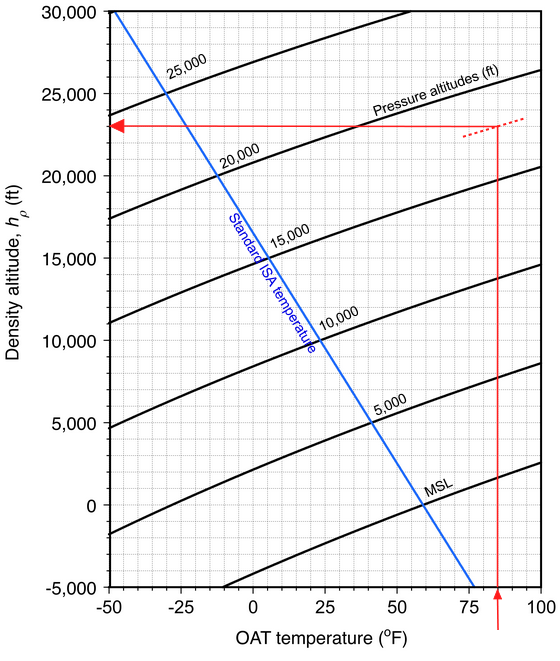
Notice that interpolation is inevitably required when using these charts, but the eye and brain are excellent interpolators. Nevertheless, while the charts provide a reasonable visual representation of the differences between pressure altitude and density altitude for variations in non-standard temperature, they should not be used as a substitute for the ISA equations for engineering purposes.
Density Ratio Calculation
Another useful metric that can be calculated from the pressure altitude and outside air temperature is the density ratio, , which is often required for analyzing aircraft and engine performance. The value of
can be obtained from
(25)
where the local pressure altitude, , is in feet and the local
is in units of
C or using
(26)
where is in feet and
is in units of
F. It is also useful to remember that the equation of state can be written as
, which is helpful when converting between density, pressure, and temperature in the ISA.
Check Your Understanding #1 – Calculating the density altitude
Use the ISA equations to calculate the corresponding density altitude, given a measured outside air temperature of 32C and a pressure altitude of 6,300 m.
Show solution/hide solution.
The relevant ISA equation is
where in this case = 32
C and
= 6,300 m. Inserting the other SI values gives
This result means that, even though the altimeter reads 6,300 m, the airplane behaves, from a performance perspective, as if it were flying at 8,136 m due to the higher-than-standard air temperature. Notice also that this calculated density altitude value agrees with the chart example given previously.
Measuring Outside Air Temperature
In aviation terminology, the outside air temperature (OAT) refers to the air surrounding an aircraft during its flight. However, its value is assumed to be unaffected by the aircraft’s passage through it; it is therefore often referred to as a static temperature. For engineering purposes, the outside air temperature (OAT) must be measured to determine air density. A simple OAT gauge can be used below a Mach number of 0.3 (the incompressible flow regime), as shown in the photograph below, which provides a relatively accurate measurement of the static air temperature. In this application, the probe is shielded from the airflow, which minimizes temperature errors from any heating caused by direct sunlight. The probe typically protrudes through the aircraft’s windshield or the side of the fuselage near the cockpit, exposing it to atmospheric air. The instrument head is mounted inside the windshield in a suitable location where the pilot can easily read it.
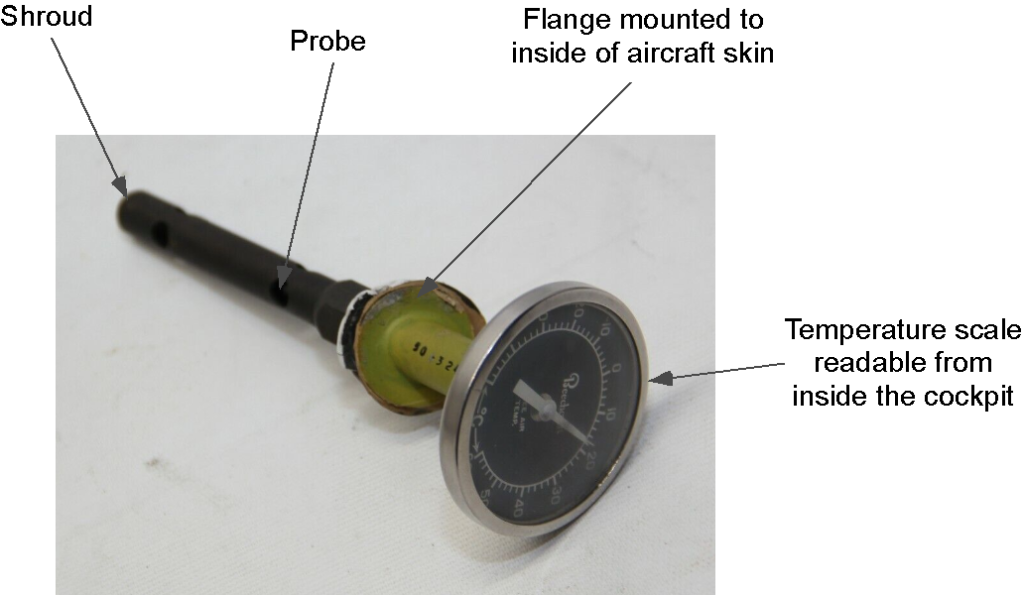
At higher airspeeds, the compressibility of the flow makes accurate air temperature measurements somewhat more challenging. In this case, the total air temperature (TAT) is measured, which is the static air temperature plus any temperature rise caused by the effects of the airflow, i.e., a total temperature. TAT probes are designed to accurately measure this temperature value and transmit signals for cockpit indications, such as airspeed and Mach number, for use in various engine and aircraft systems, as illustrated in the figure below.
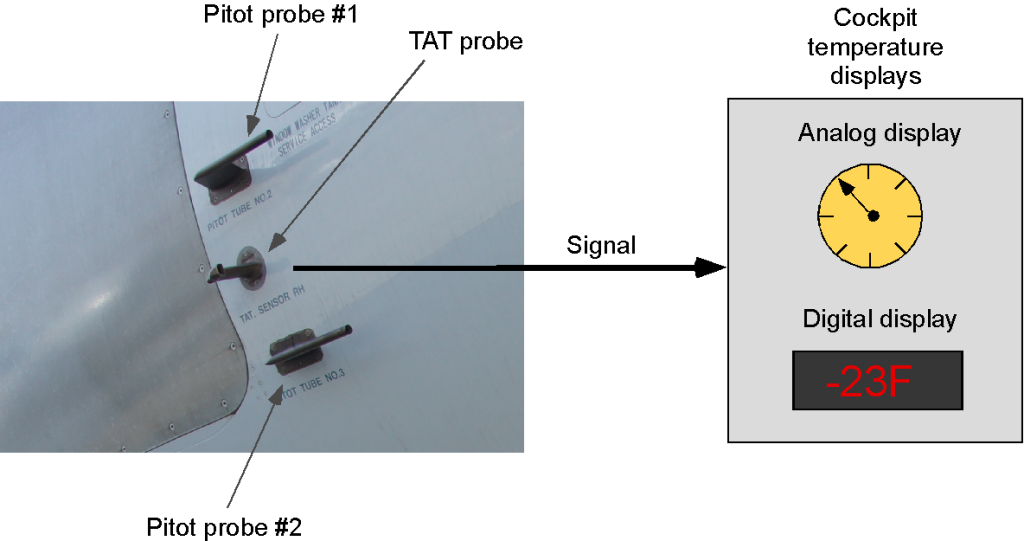
The design of a TAT probe is complicated by the possibility of ice forming on it, just as it might do on a total pressure or Pitot probe. Therefore, the TAT probe must be heated. In this regard, the ambient airflow must be directed carefully through the probe to measure the actual outside air temperature without any effects from the heater. Several manufacturers specialize in TAT probes for aircraft applications.
Practical Use of Density Altitude
The ISA equations are used universally for standardizing aircraft performance and evaluating flight test data. In many cases, a rapid estimation of the density altitude can be helpful for piloting purposes. For example, the information in an aircraft’s operating manual may be expressed as a function of density altitude. As previously discussed, pressure altitude can be measured directly on the altimeter. In contrast, density altitude is determined by calculating the pressure altitude and the local outside air temperature at that altitude.
Linearization of the ISA Equations
It will be seen from the graphs of density altitude changes versus temperature for a given pressure altitude that the relationship is almost linear, which suggests an approximation to Eq. 24 is likely to be useful for rapid estimates of density altitude, i.e., for piloting purposes when a quick estimate is required, such as for advance flight planning. Such linearizations, however, would never be used for flight test work.
To linearize Eq. 24, it can be expanded as a Taylor series about the ISA standard temperature value at a given pressure altitude and retaining only the first derivative of the series to give
(27)
where is the ISA standard temperature at the given
, i.e.,
(28)
in appropriate units. Notice that
(29)
Therefore,
(30)
when and
are in units of meters and
and
are in units of
C. Remember that
in this equation is the ISA standard temperature at the given value of
. Alternatively, in mixed units, then
(31)
where and
are in units of feet and
and
are in
C. Finally, in entirely USC units, then
(32)
so the density altitude will be
(33)
where and
are in feet and
and
are in
F.
Therefore, the linearization of the ISA equations shows that density altitude exceeds pressure altitude by approximately 120 ft per oC or 65 ft per oF when the temperature exceeds the standard ISA temperature value at a given pressure altitude. However, these results are approximate but reasonably accurate for moderate variations of non-standard ISA temperature at a given pressure altitude. However, for engineering work, the approximations should never be used in place of the ISA equations, i.e., Eqs. 17, 20 and 24.
Check Your Understanding #2 – Calculating the approximate density altitude
Given a measured outside air temperature of 32C and a pressure altitude of 6,300 m, calculate the corresponding density altitude using the approximate conversion rules.
Show solution/hide solution.
The relevant ISA equation in Example #1 gives = 8,136 m. The approximation for density altitude from Eq. 31 is
The standard ISA temperature at 8,136 m is
Therefore, inserting the numerical values gives
Therefore, this density altitude value underpredicts the value given by the complete ISA equation by only about 100 m.
Reference Pressures for Piloting
To adjust the altimeter for variations in atmospheric pressure, the pilot of an aircraft must continuously adjust the setting in the Kollsman window. In the U.S., the altimeter reference pressure is typically set to the local mean sea level (MSL) pressure, ensuring that all aircraft in the same vicinity fly with respect to the local MSL reference. In this case, when the aircraft is on the ground, the altimeter should read the approximate field elevation, which also serves as a check to ensure the altimeter is functioning correctly. The local value of MSL pressure at any given time is available from air traffic control, weather stations, and other sources.
In other countries, altimeter settings called QFE and QNH are used. The QFE is the reference pressure set in the Kollsman window of the altimeter to indicate its height above the reference elevation being used, which is usually the elevation of an airfield. In this case, the altimeter will read zero when the aircraft is on the ground. The QNH is the reference pressure that indicates the altimeter’s height above sea level, and it is the default in the U.S.
Above 18,000 ft, pilots are required to set the altimeter to the standard MSL reference pressure of 29.92 inches of Hg, in which case the altitude reading is referred to as a flight level (FL). Therefore, flight level 230 (FL230) is equivalent to a pressure altitude of 23,000 ft. All aircraft must be flown at higher altitudes relative to the same pressure datum. Over the Atlantic Ocean, for example, horizontal separation distances between aircraft may be only a few miles, and vertical separation altitudes may be as little as 1,000 feet; therefore, all aircraft must fly at an altitude measured with respect to the same pressure datum.
Check Your Understanding #3 – A question for pilots & engineers
Suppose the reported local altimeter setting at your local Florida airport before an approaching hurricane is 29.32 inches of Hg, which is the pressure at sea level for that airport at the time of day. The airport is located 88 feet above mean sea level (MSL) and features a 2,000-foot-long runway. Moving your Cessna 172 airplane and family to Alabama would be best to avoid the hurricane. The reported local temperature at their airport is 34oC, with light showers. What is the estimated density altitude for takeoff, and should you be concerned about it?
Show solution/hide solution.
The difference between the reported altimeter setting and the standard ISA reference is
The negative value indicates that the local pressure is lower than the standard pressure; therefore, even the density altitude at the ISA standard temperature will be higher. Converting to units of feet gives the equivalent pressure altitude for an altimeter setting of 29.32 as
where the value of 924.664 is the conversion factor from inches of Hg to feet. The standard ISA temperature at 555 ft is
Using the approximation in Eq. 31 to obtain density altitude from pressure altitude gives
with heights being measured in feet and temperatures in oC. Inserting the values gives
While the airport is only 88 feet above MSL, the atmospheric conditions are such that the airplane will perform as if flying at an altitude of 3,200 feet. With a full passenger load, a short and wet runway, and a relatively modest powered Cessna 172, you should worry about getting off the runway in these conditions and clearing the trees.
Altimetry in the Stratosphere
As will now be apparent, a pressure altimeter is a fundamental instrument used in aviation to determine an aircraft’s altitude by measuring the ambient static pressure. The relationship between pressure and altitude is derived from the ISA model that defines how pressure, temperature, and density vary with altitude under standard conditions. This model includes a linear lapse rate in the troposphere and an isothermal layer in the lower stratosphere.
Mechanical altimeters designed for use at higher altitudes, extending into the stratosphere, contain two aneroid capsules that expand and contract in response to ambient pressure. This motion is transmitted through a system of levers, gears, and cams to rotate a needle on the altimeter dial. Because the relationship between pressure and altitude in the ISA is nonlinear and piecewise-defined, the internal gearing must be specifically designed to match the entire ISA pressure-altitude curve, including:
- The troposphere, where temperature decreases linearly with height, i.e.,
(34)
where the constant
is the standard temperature lapse rate in the troposphere in the ISA model, as defined by
= -6.5
10
K/m = -6.5 K/km = -6.5
C/km. It represents the linear rate at which temperature decreases with altitude in the troposphere up to 11,000 meters, and where
= 15
C = 288.15 K is the standard sea-level temperature. This yields the pressure-altitude relationship
(35)
where
= 287.05 J kg
K
is the specific gas constant for air.
- The stratosphere is modeled as isothermal, so that
(36)
The corresponding pressure in this isothermal region decays exponentially with altitude, so that
(37)
where
= 216.65 K is the standard temperature at 11,000 m,
= 22,632 Pa is the corresponding pressure.
These ISA-defined pressure-altitude relationships are used to calibrate the altimeter’s interior mechanism. The gearing and dial spacing are designed to match the ISA profile precisely, including the change in behavior at the tropopause (approximately 11 km in altitude). Although the altimeter is purely mechanical, it still reads correctly across both atmospheric layers.
If a mechanical altimeter continued to assume a linear lapse rate above 11 km, rather than switching to the isothermal model, it would severely underestimate altitude in the stratosphere. For example, at an actual altitude of 20,000 m, the pressure is approximately = 5,474 Pa (ISA). If the lapse-rate model were wrongly extrapolated beyond 11 km, this pressure would correspond to only about
15,000 m, which is an error of nearly 5,000 m.
Fortunately, such an error does not occur in properly calibrated altimeters. High-altitude aircraft, including supersonic aircraft, rely on accurate altimetry for maintaining vertical separation. Their altimeters, whether mechanical or digital, are designed to follow the complete ISA model. Therefore, when flying at FL600 (60,000 ft), the altimeter will show the correct pressure altitude, matching both Air Traffic Control and the aircraft’s certified flight envelope. This approach ensures consistent and accurate altitude indication across the full range of atmospheric flight, including into the stratosphere.
Electronic Flight Displays (EFD)
Advances in electronics and software engineering have significantly transformed the instrumentation used for modern aircraft with the introduction of Electronic Flight Displays (EFDs) and Electronic Flight Information Systems (EFIS), which are often referred to as “glass cockpits.” Glass cockpits replace traditional analog gauges and instruments with digital displays, providing pilots with a more intuitive and information-rich interface, an example being shown in the figure below.
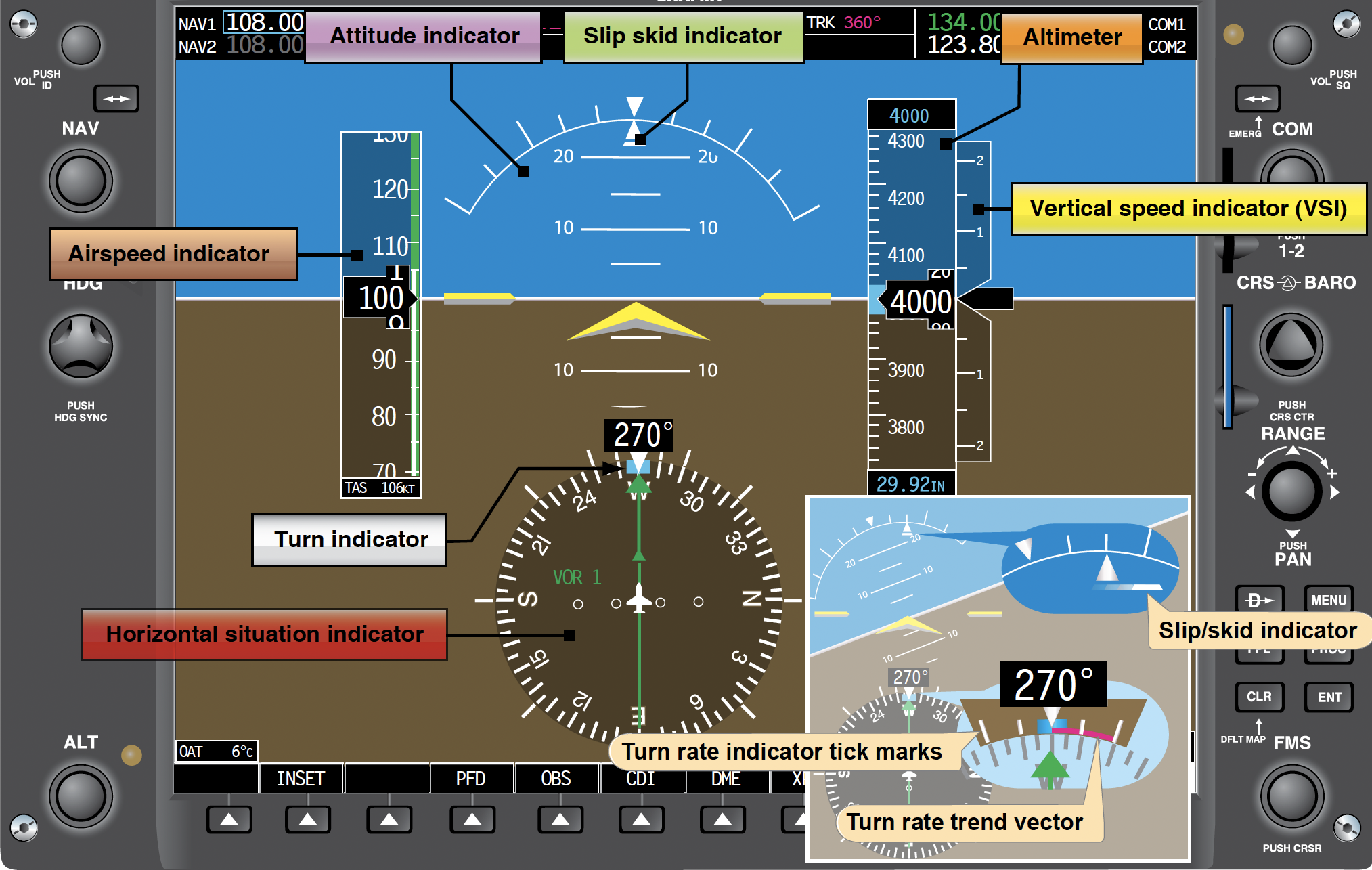
EFDs utilize the same type of instrument inputs as traditional analog gauges; however, their processing systems are entirely different. An Air Data Computer (ADC) first receives the Pitot and static pressure inputs. The ADC calculates the difference between the total and static pressures and uses equations to generate the information needed to display the airspeed on the PFD. Outside air temperatures are also monitored and introduced into various components within the software, and they are displayed on the PFD screen. These are the essential elements of an EFIS:
- Pitot-Static Inputs: EFDs still receive pitot-static inputs where the pitot tube measures the total pressure, and the static ports measure the static pressure. As with a traditional mechanical instrument, static pressure enables altitude calculation, while dynamic pressure provides the necessary information to calculate airspeed.
- Analog-to-Digital Converter (ADC): The pitot-static inputs are received by an Analog-to-Digital Converter (ADC). The ADC converts the analog signals from the pitot-static system into a digital format that can be processed by the EFD’s software and electronic system.
- Air Data Computer (ADC): The ADC, a component within the EFD system, receives the digitized pitot-static inputs from the ADC. It computes the difference between total and static pressure to determine the airspeed. All necessary corrections for SPE can be included in the software. The ADC then generates the information required to display the airspeed on the Primary Flight Display (PFD) screen.
- Outside Air Temperature (OAT) Monitoring: EFDs also monitor the outside air temperature. This temperature data is essential for various components within the aircraft systems, such as engine performance calculations and fuel management. The OAT and TAT are displayed on the PFD screen, providing pilots with real-time temperature information.
Summary & Closure
A measurement of an aircraft’s altitude during flight is fundamental to both its piloting and engineering. However, like the airspeed, the exact type of altitude must be carefully qualified. Density altitude affects aircraft and powerplant performance, a measure of the air density at the altitude at which the aircraft is flying. Density altitude, however, cannot be measured directly and must be calculated based on pressure altitude and air temperature measurements. The higher the temperature above the standard temperature at a given altitude, the higher the density altitude, i.e., the lower the value of air density. The local air density will always affect both aircraft and powerplant performance.
5-Question Self-Assessment Quickquiz
For Further Thought or Discussion
- An airplane is flying at a pressure altitude of 10,000 ft where the outside air temperature is -10oF. What is the corresponding density altitude?
- An ERAU aircraft is preparing to take off from Daytona Beach (identifier KDAB) in the summer, where the outside air temperature is 95oF. What is the approximate density altitude, and why must the pilot know this?
- If a pilot wants to estimate the approximate value of density altitude before takeoff, explain how that should be done using the cockpit instruments.
- When an aircraft flies from warmer air into an area with colder air, how will the reading on the altimeter change, and why?
- A pilot notices that the altimeter in the cockpit reads -200 ft when set to 29.92 inches of Hg. Under what circumstances could this occur?
- What are the limitations of altimeters and factors that can affect their accuracy?
- How do pilots use altimeters to navigate and comply with air traffic control instructions?
- Can you describe the effects of altitude on aircraft performance?
- How are altimeters calibrated and tested for accuracy?
- What are the safety considerations when relying on altimeters during flight?
Other Useful Online Resources
Many internet resources discuss altimetry and the practical use of altimeters in aviation. Here are just a few worth investigating:
- Read here what the FAA officially has to say about altimeters.
- A good description from a pilot’s perspective on the importance of determining altitude.
- This video provides more detailed information on the distinction between pressure altitude and density altitude.
- Video explaining the inner workings of an altimeter.
- A downloadable FAA document explaining the concept of density altitude.

